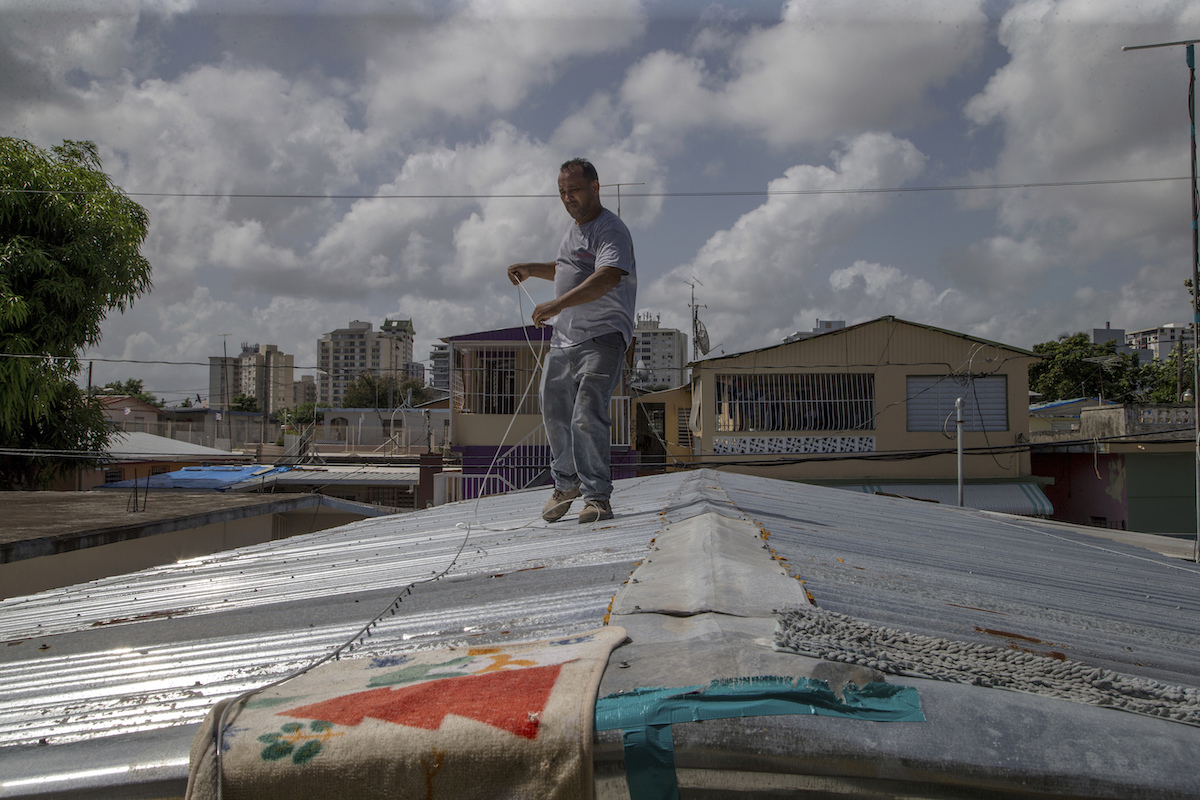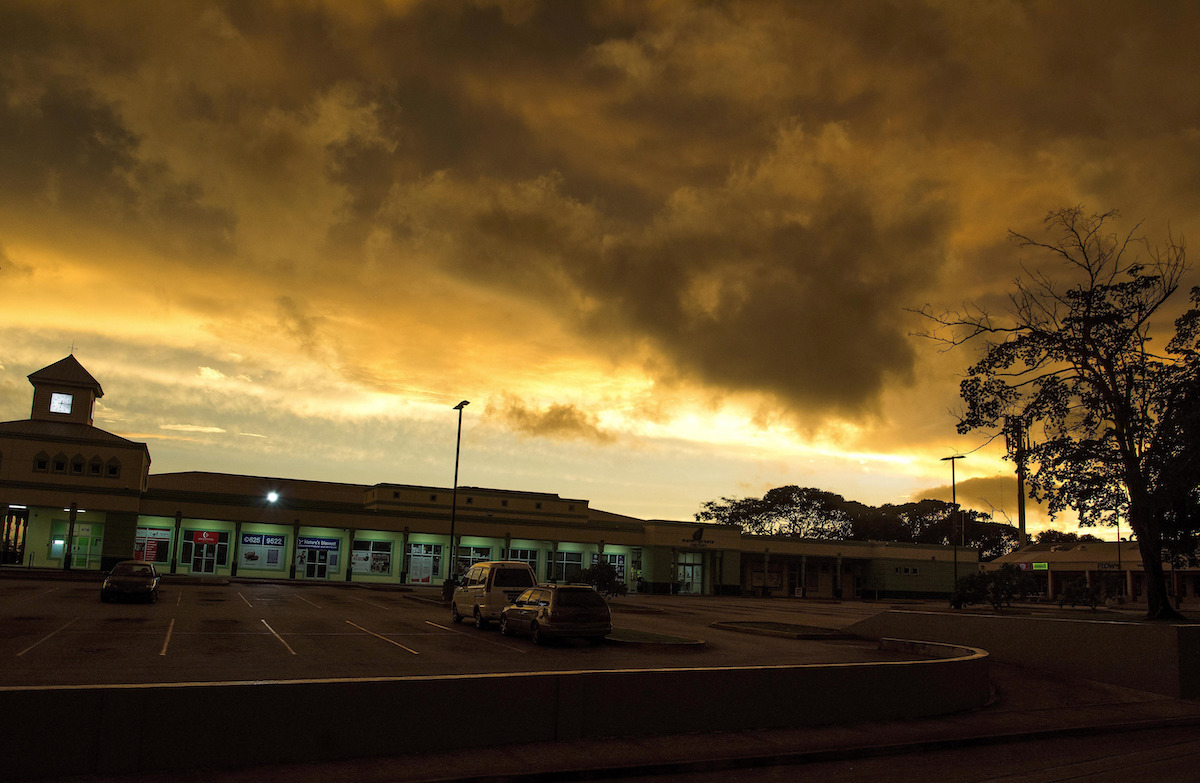

Jorge Ortiz works to tie down his roof as he prepares for the arrival of Tropical Storm Dorian, in the Martín Peña neighborhood of San Juan, Puerto Rico, Tuesday, Aug. 27, 2019. (AP Photo/Gianfranco Gaglione)
By DÁNICA COTO, Associated Press
SAN JUAN, Puerto Rico (AP) — Jorge Ortiz, a 50-year-old construction worker, was taking no chances as Tropical Storm Dorian approached Puerto Rico on Tuesday and threatened to brush past the island’s southwest coast at near-hurricane strength.
Wiping sweat from his brow, Ortiz climbed up a shaky ladder under the punishing morning sun and tied down pieces of zinc that now serve as his roof because Hurricane María ripped the second floor off his house when the Category 4 storm hit in September 2017.
He was forced to rebuild everything himself and finished just three months ago, and said he received no assistance from the local or federal government.
“They told me I didn’t qualify because it was a total loss,” he said, shaking his head as he added that he was wary about Dorian. “I’m worried that despite all this sacrifice, I’ll lose it again.”
It’s a concern shared by many across the U.S. territory, where some 30,000 homes still have blue tarps as roofs and where the 3.2 million inhabitants depend on a shaky power grid that Maria destroyed and remains prone to outages even in the slightest of rain storms.
Dorian was located about 370 miles (595 kilometers) east-southeast of Ponce, Puerto Rico, Tuesday afternoon. The U.S. National Hurricane Center said it had maximum sustained winds of 50 mph (85 kph) and was forecast to strengthen during the next 48 hours before passing near or south of the U.S. territory on Wednesday as it moves west-northwest at 13 mph (20 kph).
“The biggest problem will be the rain,” said Roberto García, a forecaster with the National Meteorological Service in Puerto Rico.
The storm was expected to dump between 3 to 6 inches (8 to 15 centimeters) of rain in the Windward islands, with isolated amounts of 10 inches (25 centimeters).
Dorian already caused power outages and downed trees in Barbados and St. Lucia, and a still-uncertain long-term track showed the storm near Florida over the weekend.


Storm clouds gather as Tropical Storm Dorian moves toward St. Michael Parish, Barbados, Monday, Aug. 26, 2019. (AP Photo/Chris Brandis)
The Hurricane Center issued a hurricane watch and a tropical storm warning for Puerto Rico and for the Dominican Republic from Isla Saona to Samaná. Tropical storm watches were in force for Saba, St. Eustatius and parts of the Dominican Republic from Isla Saona to Punta Palenque and from Samaná to Puerto Plata.
In Puerto Rico, some grocery stores ran out of bottled water as people rushed to buy supplies (including generators) and filled their cars with gasoline.
Government officials on the island warned of possible landslides, flash flooding and power outages, with Puerto Rico’s health secretary urging those with certain health conditions such as diabetes to be prepared.
The island’s transportation secretary acknowledged that crews are still rebuilding roads damaged or blocked by María. He said more than 1,000 remain blocked by that storm’s landslides.
Gov. Wanda Vázquez signed an executive order on Monday declaring a state of emergency and urged those living under a tarp to stay in one of the island’s 360 shelters if needed. Housing Secretary Fernando Gil said some 9,000 to 13,000 homes with blue-tarp roofs are located in the region that Dorian is expected to affect the most.
Officials also said they would close all public schools by Tuesday afternoon.
Jesús Laracuente, a 52-year-old construction worker who lives in the impoverished neighborhood of Las Monjas in the capital of San Juan, had his doubts about the government preparations. Blue tarps are still visible in his community, which can flood even in light rainstorms.
“The people here are prepared. We already learned our lesson,” he said, referring to María. “What despairs us is knowing that the slightest breeze will leave us without power. It’s the government that fails us.”
Vázquez said this time, the island’s Electric Power Authority has a vast inventory of equipment to cope with storm damage—$141 million worth compared with $22 million during María. That includes more than 23,000 poles, 120,000 lights and 7,400 transformers.
She said the power company also has signed 33 deals with power companies on the U.S. mainland if more help is needed after Dorian passes.
In addition, fire departments in Florida were flying teams to Puerto Rico and the U.S. Virgin Islands ahead of Dorian to bring medical supplies and equipment to assist local authorities with rescue efforts if needed.
But Freddyson Martínez, vice president of a power workers’ union, told The Associated Press that while the electric grid has improved in some areas, he worries about a lack of power line workers and post-María patches including lines fixed to palm trees.
“Those are problems that are still being corrected to this day,” he said. “These are the realities we have to face with this storm.”
Dorian was expected to move near the Turks and Caicos Islands and southeastern Bahamas on Thursday night or Friday.
Meanwhile, a new tropical depression formed Monday between the U.S. eastern coast and Bermuda. It was located about 370 miles (600 kilometers) southeast of Cape Hatteras in North Carolina and was moving north at 2 mph (4 kph) Tuesday with maximum sustained winds of 35 mph (55 kph). It was expected to become a tropical storm by Tuesday night or Wednesday and continue blowing off the U.S. East Coast this week on a path to Canada’s North Atlantic provinces.


